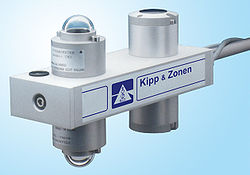
Earth's radiation balance
Encyclopedia
Earth's radiation balance is the equation of the incoming and outgoing thermal radiation.
 The incoming solar radiation is short wave, therefore the equation below is called the short wave radiation balance Qs:
The incoming solar radiation is short wave, therefore the equation below is called the short wave radiation balance Qs:
The Earth's surface and atmosphere emits heat radiation in the infrared spectrum, called long wave radiation. There is little overlap between the long wave radiation spectrum and the solar radiation spectrum. The equation below expresses the long wave radiation balance Ql:
The two equations on incoming and outgoing radiation can be combined to show the net total amount of radiation energy, total radiation balance Qt:
The difficulty is to precisely quantify the various internal and external factors influencing the radiation balance. Internal factors include all mechanisms affecting atmospheric composition (volcanism, biological activity, land use change, human activities etc.). The main external factor is solar radiation. The sun's average luminosity changes little over time.
External and internal factors are also closely interconnected. Increased solar radiation for example results in higher average temperatures and higher water vapour content of the atmosphere. Water vapour, a heat trapping gas absorbing infrared radiation emitted by the Earth's surface, can lead to either higher temperatures through radiation forces or lower temperatures as a result of increased cloud formation and hence increased albedo.

-
- Qs = G - R = D + H - R or depending on the albedoAlbedoAlbedo , or reflection coefficient, is the diffuse reflectivity or reflecting power of a surface. It is defined as the ratio of reflected radiation from the surface to incident radiation upon it...
(back-reflection to space): = (D+H)(1 - a)
- Qs = G - R = D + H - R or depending on the albedo
- G = global radiation
- D = direct shortwave radiation
- H = diffuse shortwave radiation
- R = reflected portion of global radiation (ca. 4%)
- a = albedo
The Earth's surface and atmosphere emits heat radiation in the infrared spectrum, called long wave radiation. There is little overlap between the long wave radiation spectrum and the solar radiation spectrum. The equation below expresses the long wave radiation balance Ql:
-
- Ql = AE = AO - AG
- AE = effective radiation
- AO = radiation of the Earth's surface
- AG = trapped radiation (radiation forcing, also known as the so called greenhouse effectGreenhouse effectThe greenhouse effect is a process by which thermal radiation from a planetary surface is absorbed by atmospheric greenhouse gases, and is re-radiated in all directions. Since part of this re-radiation is back towards the surface, energy is transferred to the surface and the lower atmosphere...
)
The two equations on incoming and outgoing radiation can be combined to show the net total amount of radiation energy, total radiation balance Qt:
-
- Qt = Qs - Ql = G - R - AE
The difficulty is to precisely quantify the various internal and external factors influencing the radiation balance. Internal factors include all mechanisms affecting atmospheric composition (volcanism, biological activity, land use change, human activities etc.). The main external factor is solar radiation. The sun's average luminosity changes little over time.
External and internal factors are also closely interconnected. Increased solar radiation for example results in higher average temperatures and higher water vapour content of the atmosphere. Water vapour, a heat trapping gas absorbing infrared radiation emitted by the Earth's surface, can lead to either higher temperatures through radiation forces or lower temperatures as a result of increased cloud formation and hence increased albedo.
See also
- Simple Biosphere modelSimple Biosphere modelIn climate modelling, the simple biosphere model is a model of the biosphere for use with atmospheric general circulation models that attempts to incorporate a biophysical realism in the formulation of the radiation balance and of energy at a level of appropriate sophistication to exist in the...
- Stefan-Boltzmann law - the radiation law governing much of the radiation balance of planetary bodies

